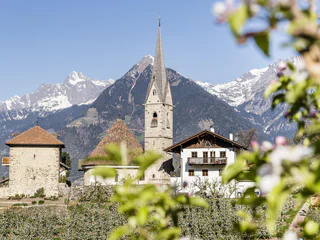
1/3
Church of San Martino in Badia
Piccolino/Pikolein, San Martin /San Martino, Dolomites Region Kronplatz/Plan de Corones
Zamki i pałace, muzea, sztuka, skarby historyczne i współczesne miejsca. Te atrakcje i zabytki są również częścią udanej podróży odkrywczej przez Południowy Tyrol.

1/3
Piccolino/Pikolein, San Martin /San Martino, Dolomites Region Kronplatz/Plan de Corones

Maranza/Meransen, Mühlbach/Rio di Pusteria, Brixen/Bressanone and environs

1/6
San Giorgio/St. Georgen - Scena/Schenna, Schenna/Scena, Meran/Merano and environs

1/3
Trafoi/Trafoi, Stilfs/Stelvio, Vinschgau/Val Venosta

1/3
Fiè/Völs, Völs am Schlern/Fiè allo Sciliar, Dolomites Region Seiser Alm

1/2
Valdurna/Durnholz, Klausen/Chiusa, Brixen/Bressanone and environs

1/4
Magrè s.S.d.V./Margreid a.d.W., Margreid an der Weinstraße/Magrè sulla Strada del Vino, Alto Adige Wine Road

S. Pietro/St. Peter - Funes/Villnöss, Villnöss/Funes, Dolomites Region Villnösstal

Merano/Meran, Meran/Merano, Meran/Merano and environs

1/2
Glorenza/Glurns, Glurns/Glorenza, Vinschgau/Val Venosta

La Costa/Seit, Laives/Leifers, Bolzano/Bozen and environs

1/4
Altavalle/Hintermartell, Martell/Martello, Vinschgau/Val Venosta

1/8
S. Giuseppe al Lago/St. Josef am See, Kaltern an der Weinstraße/Caldaro sulla Strada del Vino, Alto Adige Wine Road

Prato alla Drava/Winnebach, Innichen/San Candido, Dolomites Region 3 Zinnen

1/4
Transacqua/Ennewasser, Martell/Martello, Vinschgau/Val Venosta

1/5
Malles/Mals, Mals/Malles, Vinschgau/Val Venosta

1/2
Verschneid/Frassineto, Mölten/Meltina, Bolzano/Bozen and environs

Brunico città/Bruneck Stadt, Bruneck/Brunico, Dolomites Region Kronplatz/Plan de Corones

1/2
Collepietra/Steinegg, Karneid/Cornedo all'Isarco, Dolomites Region Eggental

S. Andrea/St. Andrä, Brixen/Bressanone, Brixen/Bressanone and environs

1/5
Merano/Meran, Meran/Merano, Meran/Merano and environs

1/7
Nova Levante/Welschnofen, Welschnofen/Nova Levante, Dolomites Region Eggental

Ponte Gardena/Waidbruck, Barbian/Barbiano, Brixen/Bressanone and environs

1/3
Velloi/Vellau, Algund/Lagundo, Meran/Merano and environs

1/3
Bressanone città/Brixen Stadt, Brixen/Bressanone, Brixen/Bressanone and environs

1/3
Pavicolo/Pawigl, Lana, Meran/Merano and environs

Tesimo/Tisens, Tisens/Tesimo, Meran/Merano and environs

S.Martino/Reinswald, Sarntal/Sarentino, Brixen/Bressanone and environs

Anterselva di Mezzo/Antholz-Mittertal, Rasen-Antholz/Rasun Anterselva, Dolomites Region Kronplatz/Plan de Corones

1/2
La Val/La Val, La Val, Dolomites Region Alta Badia